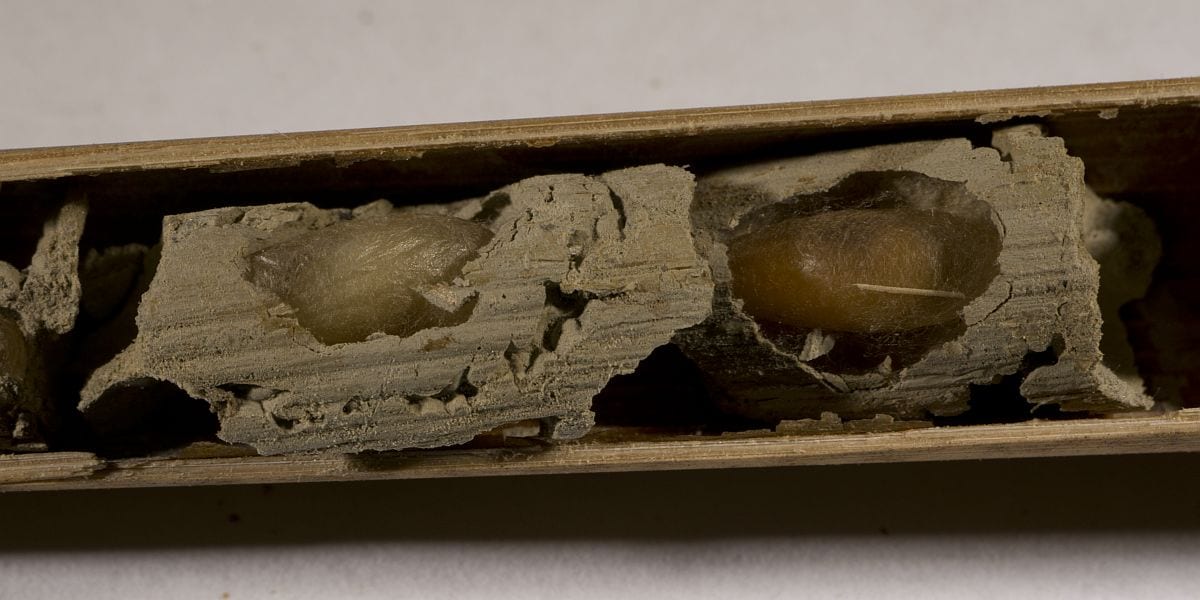I want to raise mason bees on my second-floor balcony. I will put a container of mud nearby, but what are good sources of mud? Our ground near here has much sand in it.
This question made me giggle because anybody living on or near a farm this time of year has ample supplies of mud available for free! Believe it or not, you can purchase Bee Mud Mix online – a powder that you mix with water to make your own mud – if you don’t have a local supply. Or dig up a shovel-full of soil in a less sandy, more clayey spot, and keep it well watered into the summer. Make sure you add a drainage hole in your mud container, to keep your mud from being too soupy. Mason bees prefer to use mud that is the consistency of modeling clay for their nests.
~Ellen Sousa, Turkey Hill Brook Farm, Spenser, MA
Female mason bees nest in natural or man-made cavities in wood. After laying an egg on a dough-like loaf of pollen, the mother bee closes up each of their nest cells with a wall made of mud. She works just like a potter, shaping a clay ball into the desired shape. However, the bee is not as picky as to the quality of her building materials, as long as the result is a solid, stable seal of her nesting tube that will last until the next generation hatches – often close to one year.
Moist clay can be formed and dry into a stable shape. Fine sand and other particles are an accepted addition to the mud mix, and they help to minimize shrinkage and cracking of the clay when it dries. The mix is similar in effect to a potter’s “grog.”
When collecting their building material, mason bees will work around the larger sand grains, small rocks, and other particles they don’t want, and then bring a tiny clump of clay-rich mud to their nest. I have not found research about the ideal composition of the mud, but I would estimate that it needs to contain at least 30% clay. The rate will certainly also depend on the grading of the remaining particles. Suitable materials that would work for the bee could be described as clay, loam, sandy loam, and even loamy sand. All of these soils can be found in many locations.
When providing mud for mason bees, half a pound of soil from an average field or garden should be plenty for an entire season of nest-building. It is important to make sure that the source is free of contamination, especially agrochemicals and road runoff, which could contain salt, oil residues, and other pollutants. Also, the clay or mud mix must have a workable consistency. In nature, the edge of a puddle provides areas of various degrees of moisture where mason bees and potter wasps can find exactly what works best for them. However, it is quite difficult to control this consistency in a small container in the garden. I have successfully worked with clay pots that I insert into the mud and then fill with water. Otherwise, on dry summer days with strong air movement, the water will evaporate within hours and the clay will dry out to a hard lump.

A mud dish needs to be “watered” daily during the summer. When bees are collecting mud they are vulnerable to predation by birds. A wide-mesh chicken wire installed around the water source protects the insects. Photo: Thomas Berger
I have tested a mud station from a commercial mason bee supplier. The plastic container had two levels. A piece of fabric extended down into the water-filled lower half of the container, and clay was spread out over the fabric on the other half, which was above water level. The soaked fabric kept the clay at the right moisture. However, the box was tiny, quickly exhausted, and blew over in the wind, so I reverted back to my birdbath-sized mud station with an inserted clay pot.
Besides mason bees, there are many beneficial wasps who come to gather mud. One practical thinking potter wasp was building nest cells right on the concrete block that I used as a stand for the mud station. I always fold some chicken wire over the clay station to make it harder for birds to feast on the bees, who are easy prey when they are getting loaded with mud.
~Thomas Berger, Green Art, Kittery, ME
ELA members have spent hundreds of hours learning the best ecological solutions to problems in the landscape. You can benefit from all that accumulated knowledge by posing a question to our experts. If you are stumped by a problem in your landscape or are looking for a second opinion on a potential solution, ask ELA’s Eco-Pros. Send your question to ela_new@verizon.net. And if you need additional help, refer to the listing of ELA Professionals.
***
Each author appearing herein retains original copyright. Right to reproduce or disseminate all material herein, including to Columbia University Library’s CAUSEWAY Project, is otherwise reserved by ELA. Please contact ELA for permission to reprint.
Mention of products is not intended to constitute endorsement. Opinions expressed in this newsletter article do not necessarily represent those of ELA’s directors, staff, or members.


